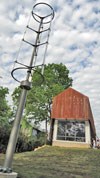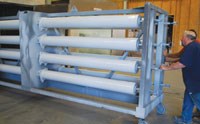Wind Power!
Building wind turbines and bringing jobs to Western Michigan
As this is written, Michigan's unemployment rate is somewhere north of 15%. Layoffs from two bankrupt auto companies and their huge supplier bases have contributed to giving the state the highest unemployment rate in the nation.
Mastech Inc. (Manistee, MI), could have been a casualty of the auto companies' crash and burn. Instead, the company is an alternative energy success story that has been featured on mainstream media news programs such as ABC's 20/20.
Historically, Mastech supplied automation and material handling systems for automotive and other applications. "We've built everything at one time or another, from fasteners to machine tools to the assembly lines at BMW's Spartanburg, SC, facility," says general manager John Holcomb.
Mastech was down to a skeleton crew of five employees when Holcomb and a regional economic development group decided to try to get into alternative energy.
"The chairman of the county board of commissioners was one of the founding board members of the American Wind Energy Association," Holcomb recalls. "He found out about Mariah Power at a conference. Mariah Power was searching for a manufacturer, and we filled the bill. So when they asked if we could build these things, we said 'sure.'"
Since partnering with Mariah Power, a Reno, NV-based developer of vertical-axis wind turbines for home and other relatively small power generation applications, Mastech has increased employment to 40. Holcomb has short-range plans to move to 140 employees and a longer-term vision that includes a new 100,000 ft2 manufacturing facility and—someday—up to 600 employees.
Wind 'Appliances'
Founded in 2005, Mariah Power developed its patented Windspire units—the company calls them wind appliances—to have a maintenance-free service life of 20 years.
Current units use a high-efficiency generator, integrated inverter and wireless performance monitor software to generate 1.2 kW of power in a 25-mph wind. A complete unit typically costs $9,000-$12,000 fully installed, but a 30% federal tax credit and local rebates in some areas sweeten the deal.
And the company is not slowing down its product development efforts. A new 3-kW Windspire will be able to meet the power needs of a typical American household, and another new product in the pipeline is the Lightspire, a light pole with its own on-board wind turbine, solar panels and battery pack. All the products will be manufactured by Mastech.
The potential upside is huge: Mariah Power estimates the market for wind energy technology at roughly $30 billion for homes, schools, commercial buildings and other applications.
Manufacturing Process
Designed for a 20-year service life, the 30-ft-tall Windspire units consist of a base pole, a center pole, airfoils to catch the wind and associated power generation/management electronics. The carbon steel base pole and high-strength steel center pole, which provides a rotating axis for the 6000-series aluminum alloy airfoils, require multiple welding and machining operations to prepare them for assembly with bearings and other components. The appliance needs wind speed of only about 5 mph to begin turning. It starts generating power at about 8 mph.
Mariah was having prototype units built by a company near its Reno headquarters, but realized it needed to ramp up production to meet anticipated demand.
Enter Mastech. According to Holcomb, the company builds Windspires at a 53% lower cost than the Reno manufacturer and is currently producing 50 units per week.
"That's working one shift," he says. "With two shifts, we would probably be able to produce more than 300 units per month." The planned new plant would increase production of Windspires and Lightspires even further.
Finishing Process
With a 20-year service life requirement, the finish that goes on poles and other metal Windspire components is important. Currently, Mastech applies a liquid urethane topcoat over a zinc-rich primer in a batch process.
For base poles, finishing begins with attachment of 16 poles to a custom indexing fixture designed and built by Mastech's in-house engineering team. The fixture rotates the poles during painting to facilitate more even coverage and features internal ground circuitry to accommodate powder or electrostatic liquid paint application.
The entire fixture is lifted by crane (built in-house, naturally) onto a wash platform for pretreatment, which consists of a four-stage wash and iron phosphate process applied manually via spray wand. An alkaline cleaner is followed by rinsing, iron phosphate application and another rinse before parts are dried in a batch oven at 175°F. Pretreatment is a zero-discharge process, with water and phosphate chemistry filtered down to 100 µm and reused through the system.
Dry poles move from the oven to the adjacent paint booth for application of a zinc-rich primer. This is followed by a cure cycle for the primer prior to application of a two-part urethane epoxy topcoat material. Topcoated parts are again baked at 175°F to cure the epoxy. The entire process takes roughly four hours.
Right now a white urethane epoxy is the only finishing option offered for the wind turbines, but Holcomb says the company will soon be using powder coating for most units and offering a few colors. "The liquid topcoat is designed for a 20-yr life in a high-salt environment," he explains. "But in places with drastic temperature ranges like Michigan, where you can go from maybe -20°F in the winter to 100°F in the summer, the urethane topcoat has a tendency to crack over time.
"Powder would be much more durable in such extreme temperatures, but not nearly as durable in the salt environment," he continues. "So, going forward the standard domestic finish will be a powder topcoat. The liquid urethane topcoat will be an option for high-salt environments."
Mastech also investigated the possibility of using UV-curable coating materials but ultimately chose powder coating instead. "We liked the idea of using a UV-curable material," Holcomb says. "We really wanted to be as green as possible, to eliminate any possibility of groundwater contamination and minimize air emissions, too. But because of our part geometries, which have multiple pockets and holes, a pass-through UV curing booth would not have worked for us. And, our finishing supplier told us that UV coatings with the life we were looking for did not exist yet. Maybe in a couple of years, but not now."
In addition to base poles, Mastech also paints the high-strength steel top pole and other Windspire parts such as generator housings. The aircraft aluminum airfoils receive no finish at all, relying on formation of a natural oxide film for protection.
Finishing quality control consists of thickness testing, a scratch test to confirm cure, and visual inspection. Mastech aims for a 6-mil total film build and is currently developing specifications for the upcoming powder process.
Moving Forward
Holcomb recognizes the limitations of Mastech's current batch finishing process, as well as its potential to be a bottleneck as production continues to ramp up. Right now, the pretreatment station, paint booth and oven are adjacent to each other in a non-climate-controlled building, and the process requires overheard cranes and lift trucks to move parts between process steps.
"Eventually we'll add a second curing oven and build a conveyor system," he says. "We've built a number of paint lines in the past, so it's no big deal.
"The main issue is part size—they would require a fairly long paint line. Right now we're doing OK with this batch system."
Longer-term plans call for the company to walk the alternative energy walk in a new manufacturing facility: Holcomb says plans call for the updated powder coating process to be driven by wind power.
Economically, Mastech's conversion from automation supplier to alternative energy manufacturer has benefited not only the company and the town of Manistee but also suppliers located throughout Michigan. "One of the goals was to make the greatest economic impact in the smallest area possible," Holcomb says. "We were able to source 97% of the parts and materials for this unit from Michigan suppliers. So it's not just that maybe we'll have 500 jobs here, we'll have a like number of jobs at suppliers in the region."
And, he adds, Mastech builds the wind turbines at a cost at or below the price quoted by offshore suppliers. "We looked at every component of this thing, and on price we are equal to or better than anything I could source in China," he says. "Plus, quality is totally controllable because it's all right here in our backyard."
Related Content
Masking Solutions Provider CFS Dramatically Expands Capabilities and Capacity
Custom Fabrication & Supplies (CFS) completed a new plant expansion packing 10 times the capacity into twice the space. It dramatically enhances the supplier’s custom capabilities to provide extremely precise and cost-effective masking solutions.
Read MoreConveyors and Paint Systems
Choosing the right conveyor system, coating technology, and ancillary equipment.
Read MoreConcrete Reinforced Bars Built to Last
Not all corrosion-resistant materials for infrastructure are created equally. Epoxy-coated steel rebar has advantages that other materials used to prevent corrosion do not.
Read MoreRobots, AI and Superb BMW Surfaces
There isn’t an automotive paint shop in the world that doesn’t have post-paint inspection and defect processing. But BMW is doing this with levels of technology at a plant in Germany that exceed all other paint shops in the world.
Read MoreRead Next
Delivering Increased Benefits to Greenhouse Films
Baystar's Borstar technology is helping customers deliver better, more reliable production methods to greenhouse agriculture.
Read MoreA ‘Clean’ Agenda Offers Unique Presentations in Chicago
The 2024 Parts Cleaning Conference, co-located with the International Manufacturing Technology Show, includes presentations by several speakers who are new to the conference and topics that have not been covered in past editions of this event.
Read MoreEducation Bringing Cleaning to Machining
Debuting new speakers and cleaning technology content during this half-day workshop co-located with IMTS 2024.
Read More
























